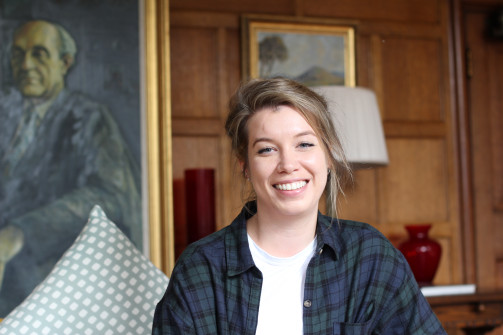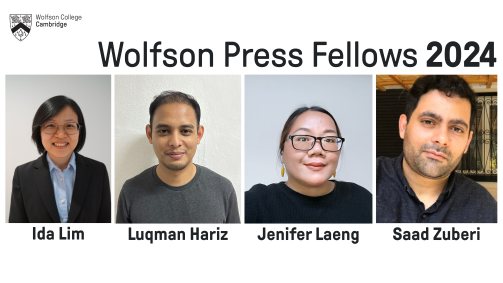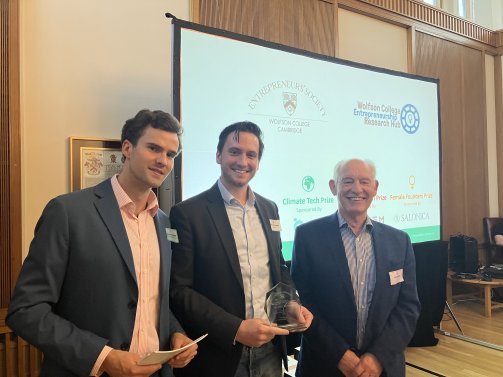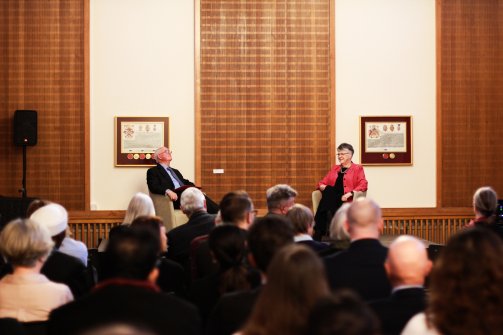How to rebuild a city with Karam Alkatlabe

Alumnus Norman Toms (1967) was stroke of the first Wolfson College Boat to participate in Bumps in 1968. We are very grateful to Norman for producing this and believe it is a great story for all alumni and current rowers at Wolfson.
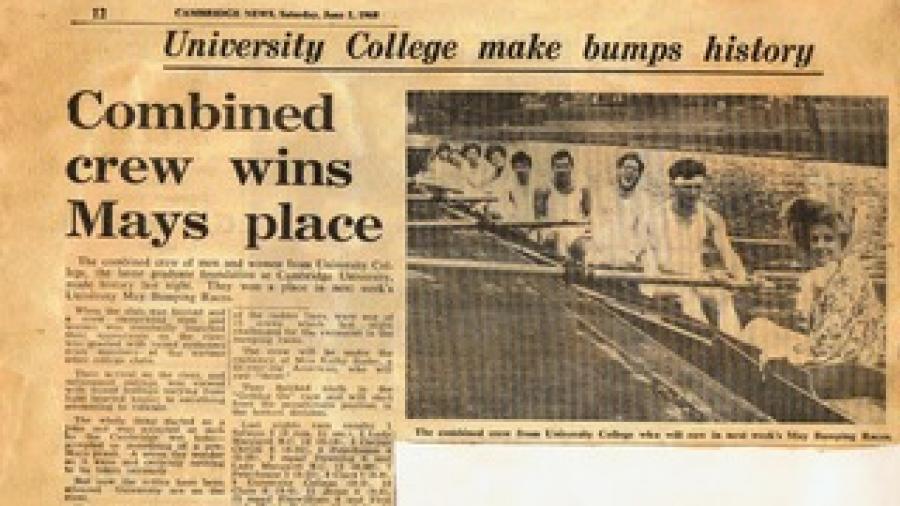
In 2005 Wolfson College hosted a series of events commemorating the 40th anniversary of the foundation of University College, renamed Wolfson College in 1972. At one of these events six of us from the 1967-1969 era, complemented by three much younger crew climbed into a boat and paddled along the river. (One of the younger members was seen making sure that a defibrillator was easily available). A member of the college who was watching asked about the history of the Boat Club and I promised to write it all down for him. However, years passed by and I let the project slip. In the meantime at least one of the early crew – Mike Bayliss, captain of the 1970 boat – sadly passed away. So did several of the senior members of College who were crucial players in the formation of the Club – notably Jack King and John Shaw. I realised that if I did not put the events of 44 years ago on paper I might never do so.
As a disclaimer, this is written from memory with the aid of some contemporaneous press clippings, and the passage of 40+ years makes memory an imprecise tool. My apologies to anyone I omitted or, worse, misrepresented.
A present-day Wolfson student would have difficulty recognising the University College of 1968. Physically it consisted of the old Bredon House – now just a very small part of the College. It had not yet developed the structures and processes essential for the efficient running of any organisation, and seemed in no hurry to do so. All matters culinary and social were run by Jenny – the niece of the President (John Morrison). Jenny and her friends all enjoyed cooking – the larger and more extravagant the meal the better. They were unencumbered by any concerns for economy, resulting in a dining experience worthy of a five-star restaurant at the price of a MacDonalds. Predictably the kitchen was turned over to more professional management a year later by a Board alarmed at the mounting losses.
On the day I arrived in College Jenny and the wine steward were arguing about how many standard measures of spirits were contained in a bottle. They had decided that the matter was better resolved by experimentation than by calculation. They had served (and consumed) over 20 measures of gin between them, but had just lost count and were looking crestfallen in the realisation that they would need to open another bottle and start again.
The story of the University College Boat Club is the story of Kathy Rader – an all-American girl who arrived in Barton Close in 1967 determined to live the 'Cambridge experience' to the full. Kathy was a somewhat larger than life girl from Philadelphia. She arrived with her mother (her chaperone, social guide and fellow conspirator). Over drinks in the bar, Mrs Rader would lay out her plans for the ideal social life for Kathy – and herself. I cannot remember the exact date when rowing was added to the list, but the idea appealed immensely to Kathy. The fact that the College lacked a boat club, a boat house, a boat or anyone who would admit to ever having rowed seemed like minor obstacles to les femmes Rader. So one day in early 1968 we were not too surprised when Kathy appeared in the bar with a senior member of Trinity Boat Club in tow and the promise of a boat. One obstacle removed.
Four other women joined in her enthusiasm – Virginisa 'Ginni' Bunker, Elaine Miller and Suzanne Cory were keen to actually row and Maria Lukianowicz was willing to cox. They felt that some heavier muscle in the stern of the boat might be advantageous. Heinz Lemke, Lachlan McDonald and Dave Richardson were competitive weightlifters. I was heavy and looked as if a bit of training might equip me to row, and John Goodman was game for anything. In the end Suzanne decided that she had come to Cambridge to carry out research, not splash around in an eight and dropped out. (Since then she has pursued a distinguished career in her native Australia).
As the 'mixed boat' became famous, or notorious, we discovered that 'Cambridge rowing' was an iconic brand, and a major commercial asset to the University. It attracted international attention and significant donations from former students, whether Blues, college oarsmen or just onlookers. A mixed boat attracted ridicule from the press and threatened to devalue the brand. We received hints (some not too subtle) that we were not welcome on the river and that all efforts would be made to keep us off.
Today, having run a company of my own, I understand the value of a brand and hence the basis for these concerns, but in 1968 the whole adventure was just a lark and we did not 'get it'. I ask myself now why the establishment did not simply pass a rule banning us? I’ll never know, but I suspect they assumed we would get bored and go away or be knocked out in the getting on races. Meanwhile our presence in Trinity’s boat house had become an embarrassment to our hosts, and they politely requested us to find another home. Fortunately John Shaw was a Fellow at University College and a respected member of Corpus Christi Boat Club. He managed to get us another boat and a home that tolerated us as long as we stayed out of the way of the serious teams. We were rowing with blades donated by Corpus, but obviously needed our own colours if we were to compete. Maria proposed the colours of her native Ukraine – blue and yellow (later some were to call it gold). Nobody had a better proposal, and blue and yellow remain the colours of the Wolfson boat today.
In the meantime a charming local vicar – Rev R.N. Evans – offered his services as coach and began the slow process of getting our unlikely crew into adequate shape to qualify for the May Bumps. The members of the crew were fit and strong, if unskillful, and his patient guidance and encouragement got us to the point where we could, in the words of the Cambridge News, “thrash our way along the course” slightly less slowly than others.
On Friday 31 May 31 1968, the boat splashed its way to the start of the getting on race. There were 15 boats and 10 places available. When the race ended University College was on the river in the penultimate position. Sadly I cannot find any record of what boats we bumped, but we made two or three bumps – not enough to get our oars, but enough to silence our most vocal detractors.
The First Bumps Supper was held on 8 June 1968. I still have the program with inscriptions across it which are too embarrassing to publish. Kathy sat at the head of the table with Christian – the Trinity man whose generosity had allowed us to get our first boat and access to the river. The party was the normal exuberant affair with youthful energy carrying the dancing into the small hours.
So ended the first phase of the University College Boat Club story. Well, nearly. As I said the story is one of Kathy Rader and there was one more chapter in that story. Over Easter of 1968 Kathy had received a diamond ring from a young man in Philadelphia. The ring, and all that it signified, was accepted and a wedding planned for Great St Mary’s on 15 June 15, a week after the Bumps Supper.
The day after the Bumps Supper we began to regroup in the bar to discover that Kathy had added one more extraordinary achievement to her first year at Cambridge – she had eloped during the Bumps Supper and married Christian. I am sure there have been many great Bumps Suppers at Wolfson in the intervening 44 years, but few can have been as eventful.
Kathy, thank you from all of us for a wonderful 1968 and all the best. We love you, and Wolfson College rowing owes you a great debt.
The feedback I received on this short history included several requests to cover the evolution of the Club from 1968 to 1970. In 1969 we were an all-male crew. To the great amusement of our female former crew members we were bumped twice in the Lents. Fortunately the crew qualified for the May Bumps and won University College’s first oar with little difficulty, even managing an over-bump to move up a total of six positions.
The crew was a collection of colourful characters, whom I had the privilege of leading as acting Captain and stroke. Heinz Lemke (7) was undoubtedly the strongest man in the boat – possibly on the river. Whenever we encountered challenging situations I would see a huge whirlpool pass on my left from his oar accompanied by a muttered Germanic “Paddy – we must do something”. Randy Henry (6), at 6’ 7” was a former college basketball player from Houston who barely fit into the boat. Jonathan King (5) had rowed for Yale first boat and was definitely slumming it in our crew – being the end of the sixties he would appear dressed as if he had come directly from Woodstock with hair to match. The crew was completed by Hugo Darlington (4) who had perfected the art of being a permanent student by stretching his PhD to 7 years; our Newfie ice hockey player Dave Hyslop at 3 and a Welsh rugby player, Wyn Richards, at bow. Lastly, the late Mike Bayliss at 2 went on the captain the 1970 boat. Mike was one of the gentlest kindest people I had ever met. My image of him will always be labouring over his beloved Morris Minor in the College car park late into the night, smiling patiently even when the car refused to start for the umpteenth time. We all miss you, Mike.
Pat Fosh contacted me to point out a major omission – the 1970 Lents Boat. My apologies to Pat and the crew; because I had bowed to pressure from my supervisor and given up rowing for that term I had forgotten the details. Pat reminds me that this was the second University College boat to win its oars, and also the first mixed boat to do so, with Pat at bow. She has provided me with the following crew list and list of bumps:
1 Ms P Fosh (Yes unbelievably the men have just initials and Pat has a Ms!)
2 J Hughes
3 P Marcell
4 M W Bayiss
5 A Burns
6 G Galluzzo
7 J Schriener
8 J Olley
Cox R Scrutton
Overbumped Corpus Christi 4, Bumped Selwyn 5, Overbumped Magdalene 4 and Bumped Emmanuel 4.
For the 1970 May Bumps we were promoted to row sandwich boat between the 4th and 5th divisions. The crew benefitted from the coaching of Johan Schreiner – a former Norwegian international oarsman who rows and skis competitively today at an age I promised never to disclose. Despite being one of the fastest boats in these divisions, the mechanism of the bumps meant that everything on the river got bumped ahead of us on day one and we had to settle with three bumps and go home without the coveted third oar. After 1970 pressure from my thesis supervisor made me reduce my participation significantly, but luckily Madeleine Devey has submitted her memoirs of the following few years in an accompanying article.
Oh – and the official college scarf? It was the creation of Randy Henry – who felt that he needed a memento of his year at University College and got an informal committee together to create a college scarf. Most of the committee were Boat Club members, so blue and yellow were essential ingredients. However, the racing colours (as in horse racing) of the College President were black and red, so the scarf incorporated all of these. The first batch used Cambridge Blue by accident, making them rare collectors’ items. I left mine in the overhead bin of a plane many years ago, and still pine for it.
Of the original 1968 crew, Maria Lukianowicz (cox) continued her work on the pathological aspect of developmental psychology; Heinz Lemke (7) pursued a distinguished academic career in Computer Science in Germany; Lachlan MacDonald (6) lives in London where he runs a civil engineering company when he is not playing the bagpipes; John Goodman (5) lives in his native New Zealand; Ginni Bunker (bow) lives and works in Kuwait and regularly visits Cambridge. While researching this article I managed to make contact with Kathy Rader (3) – now living in London. I welcome any information on the whereabouts of the others – Dave Richardson (4), and Elaine Miller (2). Many Google searches have failed to track them down.
Norman (“Paddy”) Toms was a Junior Member at University College from 1967 to 1972. He was stroke of the first College boat in 1968 and rowed in several College boats between then and 1972.
He lives in retirement in Dublin. He can be reached by email.

